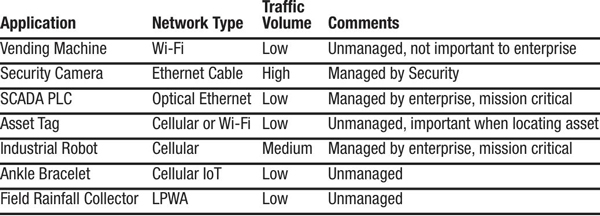The Basics of IoT (Navigating the “Soup”)
By Dave Kozischek, Art King, Corning Incorporated
Much has been written about the Internet of Things (IoT) over the last few years, discussing both the explosive growth projections in the number of attached devices and the anticipated value to global business that they will bring. The growth projections alone are staggering. From Figure 1, you can see that from 2013-2025 the numerical growth shows 100 billion IoT devices globally by 2025 with commercial/industrial electronics, communications and consumer making up the biggest segments.

Figure 1. Worldwide IoT Device Projections
Source:IHS IoT Devices Market Tracker - Q4 2018
This article focuses on the basics, key definitions and infrastructure requirements that will help networking professionals navigate through the “soup” that makes up the Internet of Things. These seven topics are covered below:
- IoT Definition (What is the “Thing”)
- IoT Connected devices (Kinds of connected “Things”)
- Areas for IoT (Where are the “Things”)
- Device Classifications (What are the “Things”)
- Network Types (What do the “Things” connect to)
- Network Requirements (How do “Things” affect the network)
- Assessment for Network Design Considerations (How to design using the “Things”)
This article provides understanding on how to attach these devices to various networks, what their potential impact could be to the network, and help develop planning guidelines and processes. Let’s start with some basics.
- IoT Definition (What is the “Thing”)
IHS defines an IoT device as “a device which has some form of embedded connectivity that allows the device to be directly connected to the Internet (i.e., IP addressable), or allows the device to connect (tether) to an IP addressable device. This connectivity can be wired or wireless.”
- IoT Connected Devices (Kinds of connected “Things”)
IP Addressable Devices — A device that can connect to the Internet directly and has a unique IP address. Examples range from machine-to-machine (M2M) communication down to well-known devices like smart phones and laptop computers. Connectable Electronic Devices — A device that can directly connect to other devices and transmit basic information. These devices have the built-in capability to connect to networks or other devices. One example is wireless speakers that can connect to a stereo or your smartphone. Other examples could include kitchen appliances that connect to your home network to provide enhanced usability.
- Application Areas for IoT (Where are the “Things”)
There are many areas where devices can connect to a network. Some of these include but are not limited to:
- Automotive and transportation — In-car communications like “On Star”
- Commercial and industrial electronics — This area could also include devices for power and energy, lighting and building automation.
- Communications — Equipment associated with voice and data transmission which includes devices found in network transmission like: HFC, DSL, FTTH/PON hardware, CPE (including mobile CPE), and others.
- Computing — This area includes things like desktop PCs, laptops and servers.
- Consumer — One of the biggest areas for connected devices, this area includes personal and home electronic devices.
- Medical — Includes all electronic equipment associated with medical services, such as over-the-counter, durable pharmaceutical, clinical and hospital equipment.
- Device Classifications (Whar are the “Things”)
IoT devices come in three basic types of classifications… nodes, controllers and infrastructure. Each of these performs different functions in the complete ecosystems of the Internet of Things. The basic definitions of these classifications are:
- Nodes — Nodes are the simplest of the devices. Nodes are responsible for collecting and transmitting data. The use of sensors that collect such things like environmental and location information are very common for nodes.
- Controllers – A controller is a device with a smarter user interface, a more powerful processor, and the ability to run applications.
- Infrastructure — These devices form the active component part and transportation of the IoT information.
- Network Types (What do the “Things” connect to)
Given the variety of devices needing to connect, different networks are needed for connection and transport. The two choices are wired and wireless networks.
Wired networks make up the backbone of the Internet of Things. The three main types that are used for “first connection” are FTTH (fiber to the home), DSL (digital subscriber line) and HFC (hybrid fiber/coax) networks. FTTH is an all fiber architecture, but DSL and HFC networks are made of a combination of fiber and copper structured cabling products. These products include fiber, cable, hardware, splitters, WDM devices, closures and other components.



Wireless networks make up the other area and they include personal area networks (WPAN) like Bluetooth V4.0, IEEE 802.15.4-2006, wireless USB, wireless local area networks (WLAN) such as IEEE 802.11a, 802.11b, 802.11g, 802.11n, 802.11ac and finally, cellular wireless wide area networks (WWAN) like EDGE, EV-DO (x1 Rev 0, Rev A, Rev B), HSPA, HSPA+, LTE, W-CDMA (UMTS), WiMAX, TD-SCDMA make up the last area.

Regardless of whether the last mile is fiber, coax, twisted pair or wireless, all networks lead back to fiber optic cable and hardware. This is because the following factors are critical to ensure sufficient bandwidth and connectivity when designing networks for the Internet of Things:
- Ease of installation
- Ability to connect to existing infrastructure
- Efficient use of space
- Reliability and robustness
Fiber provides all the benefits above and more.
- Network Requirements (How do the “Things” affect the network)
There are a significant number of network technologies supported by IoT vendors. IoT vendors will offer the best network technology for their systems, ranging from an Ethernet cable down to wireless low-power, wide-area (LPWA) service. Since IoT devices ultimately connect to an application, the data traffic from the IoT devices will travel over an IP network, either private or the Internet, to servers in an enterprise data center or a cloud service like Amazon AWS or Microsoft Azure.
For every network type, planning is critical to ensure the IoT connectivity needs are fully satisfied.
Table 1 includes several use cases and network examples.

Table 1. IoT Network Needs
- Assessment for Network Design Considerations (How to design using the “Things”)
In planning and budgeting for IoT, the business bringing in the service should consider all expenses necessary to prepare their network for the increased volume of applications. Assessments of the target networks are used to develop the additional network improvement budget requirements.
Example assessment considerations:
- Wired Ethernet could require separate Ethernet switches if the IoT devices are unmanaged or connect to an external cloud service.
- Wi-Fi could require a different SSID and authentication method than what is presently in use.
- A Wi-Fi engineering assessment may be required to increase network coverage via more access points.
- A cellular coverage assessment on IoT device’s service provider/frequency band throughout the enterprise may be necessary to ensure network coverage.
- Cellular IoT checks coverage and ensures the installed base station transmitting indoor signal supports the NB-IoT protocol.
- Attempt LPWA network trial connection to ensure LPWA network availability before installation.
IoT can influence IT network goals. For many enterprises, there are economic benefits to architectural convergence of many physical networks onto individual logical network slices sharing the same physical network; yet, each network slice is not connected or aware of other slices. This design trend is driving an enormous amount of fiber optic cable being pulled farther towards the edge of networks to enable the “fiber-deep” strategy. How and where IoT leverages this fiber can affect the implementation costs.
Summary:
There is a wave of IoT devices and services, 100 billion in 2025, coming at the enterprise right now. This wave will drive incremental expansion and capacity increases to existing networks and, in some cases, the creation of segregated IoT overlay networks. Network teams in the enterprise and their systems integrators will be asked about design and plan for the arrival of these IoT devices and networks.
The Internet of Things is here to stay — we’re beginning to see IoT-enabled products in mission critical industry roles, cementing their place in the way we do business. Automated robots on manufacturing and distribution lines and wireless infrastructure for patient data in hospitals are just two examples of IoT’s rising importance in our society. Ensuring that your network is ready to handle wireless and wireline IoT is critical to ensuring you’re ready to take advantage of all these “Things.”




